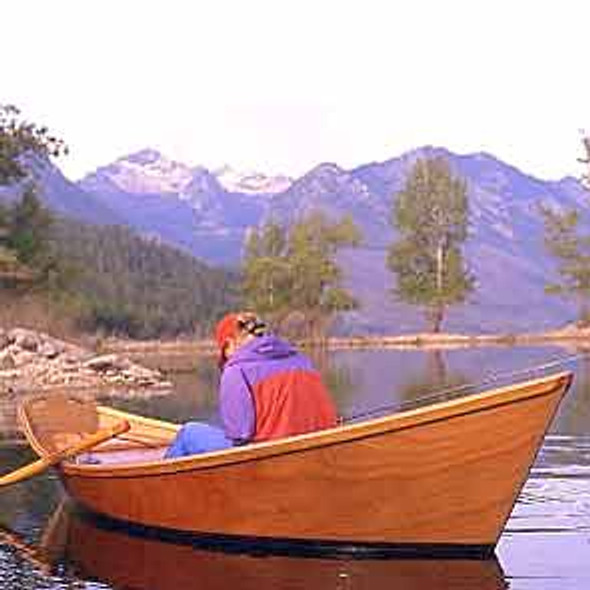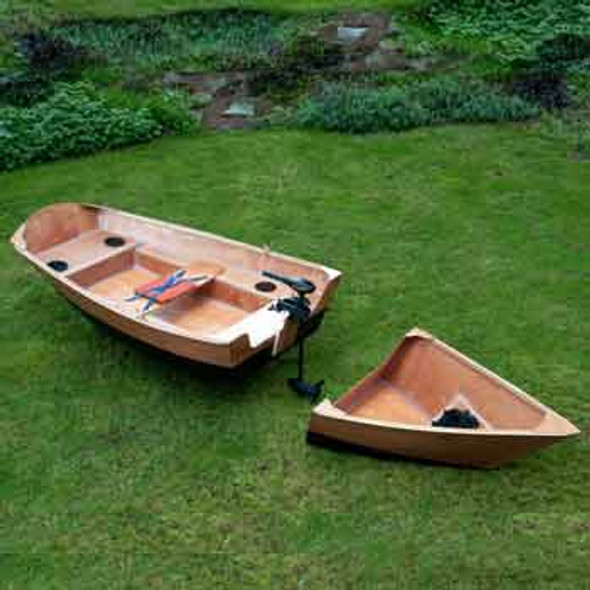Description
A little history:
The concept of a small boat made of styrofoam always intrigued me, but I never got around to design and build one until now. What motivated me was a combination of forces: My becoming a senior citizen, and the resultant decrease in upper body strength. A lightweight transportable boat seemed just what I needed (or is that wanted). Anyway, I had a hull shape that would lend itself to flat panels of foam, and that is my WEDGE design. It's simple, functional and easy to build. I had to make some minor changes in form, to accommodate the foam sheet material. But, the biggest hurdle would be structural. How to develop a tough skin on the soft and pliable foam. I knew that I did not want to use epoxy, for 3 reasons: It can be toxic to some people, it is expensive, and third, it eats most foam board. The 1 inch thick foam sheets chosen can be purchased at any home improvement store, and are inexpensive, under $10 ea.

All that being said, it was imperative that the foam structure be protected from the elements. I had to develop a process that was strong, easy to applly, and ridged. Ultimately I decided to coat the completed hull with multiple layers of 3.25 ounce fiberglass cloth. This is what I use in my T&G Process, and it is easy to work with. Finally I had to choose a bonding agent, and after many tests using different glues and adhesives, settled on a procedure the I am now calling "SKIN ON FOAM". The following will describe in simple terms and photos how it all comes together to produce a lightweight, comfortable, easy to build, and durable small craft. Welcome to The FOAM BOAT.
As you can see, this is a one passenger, 2 module hull, with exceptional buoyancy. It can be paddled, rowed or motorized. Needless to say, it is unsinkable, having 2 buoyancy chambers, as well as the foam structure. With a 200 pound occupant, it draws only 3 inches of water.
It fits in most Trucks, Vans, SUV's, RV's and even some Cars. It's a 30 pound wonder!

The basic building blocks of the design are outlined above. Length, width and height are all developed based on load requirements and ease of handling. The wedge shape is proven, and places the operator at the area of greatest buoyancy, providing a well balanced boat that is easy to paddle. Because of the ample beam at the stern, the boat is also stand-up stable.

The assembly process:
The Glue of choice for bonding all the foam panels together is PL300 Foam Board Glue, available in 10 ounce cartridges. About 3 cartridges will be required. It spreads easily, and cures in a few hours. The panels should be held together with high stick masking tape until the glue is dry.

Once the modules are assembled, the outside corners need to be rounded, in preparation of the "Skin on Foam" Process. This involves shaving and sanding to achieve the desired results. When both modules are complete, an application of a bonding agent must be added to the entire inside and outside surfaces of each hull. This allows the fiberglass to be properly adhered to the foam core. Without it, the finished fiberglass would bubble and peel off the foam.

The photo above provides a glimpse of what the glass cloth looks like, and how it is cut and placed on the hull. Bonding glue will first be applied to the hull, then the glass cloth is place in location, smoothed out, and finally a wetting layer of bonding glue is applied and worked through the cloth. This process is repeated for at least 2 layers of glass cloth.
It is very important to note that protective gloves must be worn at all times when working with the glass cloth and glue. The good news is that the glue is a water clean up type, and the brushes used can be washed and reused again and again. Not so with epoxy!

Lightly sand the lapped edges of the fiberglass to smooth out, being careful not to sand through the surface. Now apply the second layer of fiberglass over the entire bottom and sides, using the same process, being careful to under-lap the previous layer. This will allow you to sand a feather edge for best appearance, when complete. Inspect the entire hull for dry spots or exposed fiberglass. Apply local glue mixture to develop a good finish. For best results, a light sanding between layers is suggested. ALLOW TO CURE OVERNIGHT.
Now, lightly sand the entire hull, inside and outside to achieve a smooth finish. Set this Module aside and prepare the next Module for the same "Skin on Foam Process".
On the water:
I found the FOAM BOAT to be very practical. It is easy to transport and set up. It is also comfortable and safe, and, with proper care, should give many years of service.

As mentioned earlier, the boat handles very well. Although not pictured, I was able to stand without fear. Also, I was especially pleased how well the hull performed under paddle power. I would suggest you use a cushion on the seat, for comfort, and for a better ergonomic paddling height. Also, the use of Kayak paddles is recommended, for best in water performance.
After water tests, and further use, I have found the FOAM BOAT to be a very safe and fun little craft. It literally sits on top of the water, and then moves through the water with ease. If you don't mind having to be somewhat careful regarding the hull's relatively thin skin, no pun intended, you will enjoy the ease of transport, set-up and long term use of the FOAM BOAT. In fact, you will probably build another one for your significant other to enjoy with you.
Ken
Happy and safe boating!










